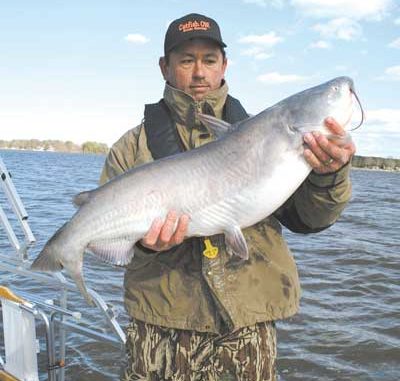
Wateree’s big blues are a great winter fishery for hardy anglers.
Catfishing during the winter was once considered foolishness by the majority of fishermen in South Carolina.
But the introduction of blue catfish into the Santee Cooper lakes many years ago began to change that perspective. Fishermen there proved that blue catfish could be caught in big numbers and sizes throughout the year.
Now, those blue cats have spread to numerous lakes and rivers in South Carolina, and they offer exceptional fishing during the coldest months of the year.
One special place is the Kershaw County treasure of Lake Wateree. According to fishermen and biologists, the wintertime fishing at Lake Wateree is beginning to rival that of any of the big-name catfish waters.
Rodger Taylor of Rock Hill has fished Wateree for several years as a catfishing guide, and he has witnessed the explosion of blue catfish.
“The fishing has become absolutely phenomenal,” Taylor said. “For several consecutive years, those of us who fish Lake Wateree have seen a big upward trend in terms of numbers and sizes of blue catfish. The blue catfish have become a rock-solid fishery in the lake.”
Taylor has developed some specific strategies for taking these Lake Wateree blues during the cold weather.
“The cold months of January and February, right on through April and early May, are absolutely sensational for catching trophy-sized and big numbers of blue catfish,” he said. “The key to success is paying attention to a couple of very important details.”
“First, fish where there is forage for the catfish, and that is primarily threadfin shad,” Taylor said. “Second, the depth and bottom topography is very important to where these fish will be found.”
Taylor said he actually relies on two different strategies during cold-weather months.
“One strategy when I focus on really big fish is to anchor and fish a specific, fixed target,” he said. “However, drift fishing in a controlled-drift manner is an excellent technique for hooking big fish. It is the best way to load the boat with lots of fish in the 2- to 8-pound class. Lake Wateree is full of catfish that size.”
When anchoring, Taylor will usually fish in the upper third of the lake. The water depths will vary, but he’ll typically anchor in less than 20 feet of water and set baits out all around the boat.
“The deep holes are the focal points, but those aren’t the only places I fish,” Taylor said. “I don’t catch a lot of the big catfish right in the middle of the deep holes, but the close proximity to deep water is a key to success. I like to fish along the edges of these holes, where the old Catawba River channel winds through the upper end of the lake.”
“I use the (depthfinder) to find edgelines where the river drops into deep holes,” he said. “Find that — with the combination of forage — and you are in a potential hot spot. Seeing big fish marked on the graph is good but not a requirement. If you’ve got the deep-water access and plenty of forage, the big blues are likely to be in the area. If they are not there when you set up, odds are good they’ll be there soon.
“I’ll anchor just above the spot I want to fish,” he said. “Usually, the best fishing is where there is some current, when water is being released upstream from Great Falls Dam. The current does seem to put the blues in a better feeding mode. It’s not essential, but I like current when anchor fishing.”
“Once I’m set with the anchors, I put out several rods,” he said. “If I’ve got a couple of people fishing, I may put out six or eight rods, but it also depends on how fast the fish are biting. Sometimes, the action can get fast and furious, and it’s hard to keep up with too many rods.”
“The bait is also critical to success,” Taylor said. “Big blues eat a lot of different things, but there are some things they seem to prefer. The best all-around, consistently-producing wintertime bait I’ve found is cut bait, with white perch, gizzard shad, threadfin shad and bluegill all working well.”
Taylor will usually scrape the scales off the white perch and bream and cut them into really big chunks. He said this allows the baits to give off more scent, always an important ingredient to catfish success he said.
“In fact, a lot of the largest fish my clients have caught were taken on the head portion of a big white perch,” Taylor said. “Even if it’s a fairly large perch or gizzard shad, the whole head is great bait for a big blue. The section I’ll cut from the body is often two or three fingers wide.”
Taylor has caught blues over 60 pounds from Lake Wateree and knows of even larger ones that have been caught. He said catching fish in the 20- to 30-pound range is very realistic.
Once baited up, Taylor will cast his rigs out in a fan-like manner, downcurrent from the boat. He likes to cover the slope into the deep water, the edgeline, and the shallower water on top of the ledge.
“Usually, the fish orient along the drop, but at times they’ll actually be a bit deeper down the slope or on the flat,” he said. “It’s best to cover all possibilities.”
He’ll give the area at least 30 minutes to produce before moving.
“You need to have some patience, but not too much,” Taylor said. “If I’m not getting any activity, not even catching smaller fish, then I’ll seldom give a spot much more than 30 minutes. I may not move far, but I’ll change locations.”
Another method to catch both quality and quantity of Wateree’s wintertime blues is drifting.
Dieter Melhorn is another catfish addict who fishes Lake Wateree. Like his buddy Taylor, Melhorn will anchor at times, but he really enjoys drift fishing.
“Drift fishing is anything but a random method of fishing,” Melhorn said. “The techniques we use ensure (that) we present the bait in a very controlled presentation. One reason is we can better determine a daily depth pattern by having a specific drift plan. Plus, we can track our fishing drifts using our GPS, so we can repeat a certain drift when we hit a really good spot.”
Melhorn said drifting enables him to effectively cover a large area. If the wind is calm, he will use his electric trolling motor to move the boat.
“Some of the open-water structures I drift are large, so I’ll make a couple of passes over the area to check them out,” he said. “Sometimes, the catfish are scattered on these structures, so drifting can be a very effective method. During February, a typical range will be from 20- to 35-feet deep, but it can change daily.”
Melhorn said another key to drifting success is boat control.
“Boat control is essential to making a good presentation of the bait,” Melhorn said. “When drift fishing, you can have all the other factors working, but if the boat is improperly positioned on your target drift or moving too fast or too slow, you won’t catch as many fish, particularly big fish.”
Melhorn likes to drift at a fairly slow speed, about 0.3 to 0.6 miles per hour. He uses his GPS to track his boat speed.
“On some days, the wind can get really strong, and it’s hard to keep the speed that low,” he said. “I’ll put out sea anchors, or drift socks, to keep it as slow as I reasonably can. We’ll catch fish even in the 0.7 to 0.8 miles-per-hour speed range, but slower is better.”
Melhorn will fish along the ledges along the main river channel, junctions of creeks with the river and across flats that have humps and ditches coursing through them.
“Find these type bottoms with big pods of shad, and it’s worth a drift or two,” he said.
Melhorn uses smaller chunks of the same baits Taylor uses when anchored.
“When drifting, we’ll use finger-sized chunks instead of the big baits,” Melhorn said. “We’ll catch both numbers of fish, as well as big fish, when drifting with these smaller baits.”
Melhorn said the drift rig is also a key. It starts with a slip weight consisting of several split shot stuffed in a parachute cord or shoelace to keep the rig on the bottom. Melhorn said this “rope weight” vastly reduces snags. Melhorn and Taylor both make their own rope weights, but they are available commercially, with the ¾-ounce and 1-ounce sizes being the most popular.
“Depending on the wind, depth and size of bait being fished, I can change the weight so I’ll stay in contact with the bottom but not drag into it,” Melhorn said. “I want the sinker to bump the bottom frequently, to maintain contact with the bottom, but I don’t want it dragging across the bottom and dredging into it.”
Melhorn uses a 30- to 36-inch leader tied to a barrel swivel, above which a slip sinker is threaded. A 2-inch cork float is threaded onto the leader about six to eight inches above a 6/0 to 8/0 circle hook.
“The addition of the float not only significantly reduces snags and time-consuming rigging, but it keeps the bait slightly off the bottom, right at eyeball level for the blue catfish,” said Melhorn, who will use as many as six or more rigs on days when the wind is favorable.
“My setup is simple but effective,” he said. “My two center rods will be the furtherest back, about 125 feet. The next rods to the side are placed about 75 feet back, and the outermost ones are about 50 feet back. Arranged like this, when I drift a pattern that is not a straight line, I don’t get tangled lines. This is important, because sometimes I need to follow the contour of a drop or ledge to stay in the area where catfish are biting. I can use the electric motor to maneuver the boat and the rigs will not tangle.”

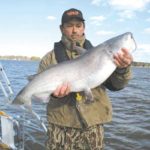
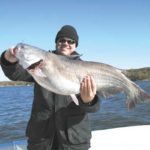

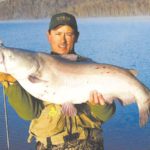
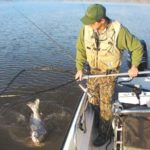
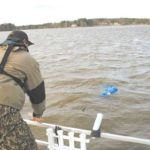
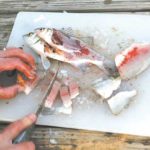




Be the first to comment